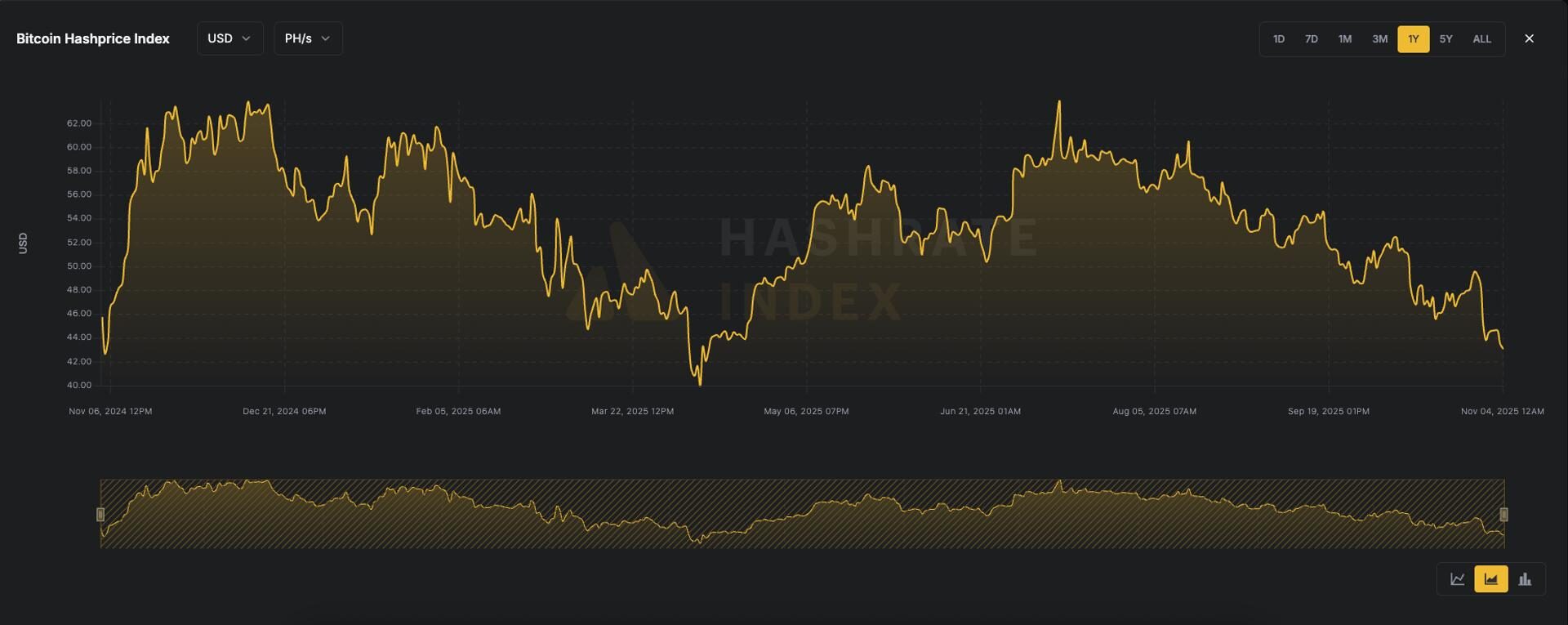BTC Mining Profitability Slumps as Hashprice Falls to Multi-Month Low
Hashprice drops to $43.1 PH/s as bitcoin’s price correction, low fees and record hash rate squeeze miners’ margins.
By James Van Straten, AI Boost|Edited by Oliver Knight
Updated Nov 4, 2025, 1:27 p.m. Published Nov 4, 2025, 1:27 p.m.

- Bitcoin’s hashprice, the expected daily value of 1 TH/s of mining power, has fallen to its lowest level since April amid a 20% BTC price decline and subdued transaction fees.
- Network hash rate remains above 1.1 ZH/s, pushing mining difficulty to an all-time high of 156T and prompting miners to diversify into AI and HPC data centers for steadier revenue.
Hashprice has plunged to its lowest level since April, when bitcoin was trading around $76,000, now sitting at $43.1 per petahash/second (PH/s).
Hashprice, a term coined by Luxor, refers to the expected value of one terahash per second (TH/s) of hashing power per day, representing how much a miner can earn from a specific amount of hashrate. It is influenced by bitcoin’s price, network difficulty, block subsidy and transaction fees.
As bitcoin has corrected roughly 20% from its October all-time high to $104,000, and transaction fees remain at bear market levels, miner revenues have come under increasing pressure.
STORY CONTINUES BELOW
According to mempool.space, processing a high-priority transaction currently costs about 4 sat/vB ($0.58), while average transaction fees on an annual basis are at their lowest levels in years.
Hash rate, the total computational power used by miners to secure the bitcoin network, remains just below all-time highs at over 1.1 zettahashes per second (ZH/s).
This has coincided with a recent difficulty adjustment reaching an all-time high of 156 trillion (T), up 6.3%.
The difficulty adjustment recalibrates roughly every two weeks to ensure that new blocks are mined approximately every ten minutes, maintaining network stability as mining power fluctuates.
Declining bitcoin prices, low transaction fees and record-difficulty are all weighing on bitcoin mining profitability.
As a result, bitcoin miners have pivoted to AI and high-performance computing (HPC) data center operations to secure more reliable revenue streams. By locking in longer-term contracts with data companies, miners can stabilize cash flow and reduce reliance on volatile bitcoin market conditions.
AI Disclaimer: Parts of this article were generated with the assistance from AI tools and reviewed by our editorial team to ensure accuracy and adherence to our standards. For more information, see CoinDesk’s full AI Policy.
More For You
Oct 16, 2025

Stablecoin payment volumes have grown to $19.4B year-to-date in 2025. OwlTing aims to capture this market by developing payment infrastructure that processes transactions in seconds for fractions of a cent.
More For You
By Oliver Knight|Edited by Sheldon Reback
29 minutes ago

A surging U.S. dollar and expectations of slower Fed rate cuts fueled a broad crypto sell-off, sending bitcoin and ether to multi-month lows.
What to know:
- Roughly $1.4 billion in crypto derivatives positions were liquidated as selling accelerated across major exchanges.
- Aster plunged 17.5%, while solana and BNB hit fresh lows while privacy coins like monero and zcash outperformed.
- The DXY dollar index hit 100 for the first time since July, signaling renewed strength that weighed on bitcoin and broader risk markets.
-
Back to menu
Prices
-
Back to menu
-
Back to menu
Indices -
Back to menu
Research
-
Back to menu
Consensus 2026 -
Back to menu
Sponsored
-
Back to menu
Videos -
Back to menu
-
Back to menu
-
Back to menu
Webinars
Select Language







